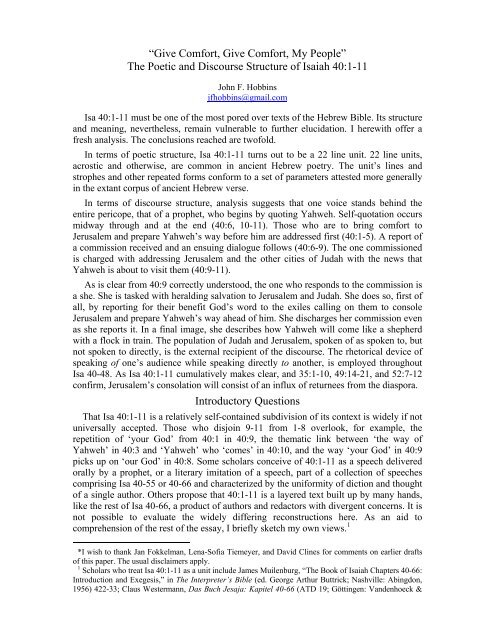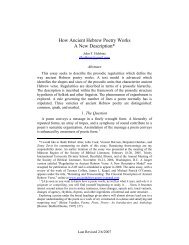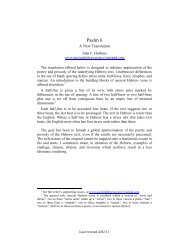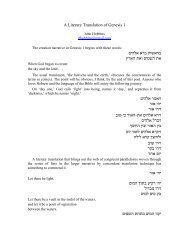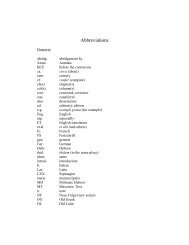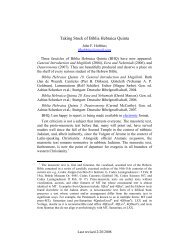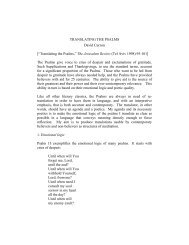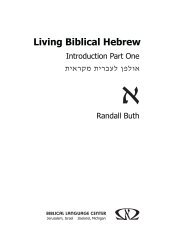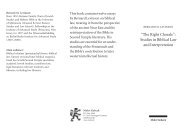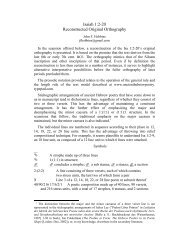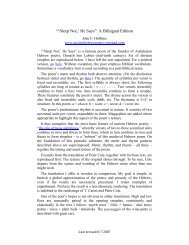Give Comfort, Give Comfort, My People - Ancient Hebrew Poetry ...
Give Comfort, Give Comfort, My People - Ancient Hebrew Poetry ...
Give Comfort, Give Comfort, My People - Ancient Hebrew Poetry ...
- No tags were found...
You also want an ePaper? Increase the reach of your titles
YUMPU automatically turns print PDFs into web optimized ePapers that Google loves.
Isa 40:9- 4 -make straight in the wilda highway for our Godעַ ל הַ ר-גָּ בֹהַּעֲ לִ י-לָ ְךמְ בַ שֶּׂ רֶ ת צִ יּוֹןGet yourself up a lofty mounto heraldess to Zionהָ רִ ימִ י בַ כֹּחַ קוֹלֵ ְךמְ בַ שֶּׂ רֶ ת יְרוּשָׁ לָ םִlift your voice with powero heraldess to JerusalemOn the basis of a regularity of ancient <strong>Hebrew</strong> poetry attested more generally, wherebya verset contains no less than two and no more than three prosodic words, I parse twoshort clauses of 40:7 and 40:8 as distinct versets. It is also natural to propose examples ofweak enjambment in 40:7 and 40:8. This is after resituating the last clause of 40:7 at thehead of the first line of 40:8, for which I present arguments below:Isa 40:7Isa 40:8Isa 40:7, 8 [not cases of enjambment]כִּ י-רוּחַ יְהוָ הנָשְׁ בָ ה בּוֹFor Yahweh’s breathblew upon itוּדְ בַ ר אֱ ֹלהֵ ינוּיָקוּם לְ עוֹלָ םBut Yahweh’s wordThe grass is searstands foreverיָבֵ שׁ חָ צִ ירנָ בֵ ל צִ יץthe bloom gone paleAn additional case of enjambment may be posited in the first line of 40:9. A verset of 3syllables is thus created. 3 syllable versets are common enough in ancient <strong>Hebrew</strong> poetry.Two examples occur in the first line of 40:3, already discussed.Isa 40:9עַ ל הַ ר-גָּ בֹהַּעֲ לִ י לָ ְךמְ בַ שֶּׂ רֶ ת צִ יּוֹןGet yourself up a lofty mount o heraldess to ZionIt is also possible that עֲ לִ י לָ ְך ‘get yourself up’ should be treated as a single prosodicword (so MT). The subdivision of this line is in any case irrelevant to a conclusion of adifferent order, namely, that:(2) Isa 40:1-11 contains exactly 22 lines. If and only if the cases of weak enjambmentproposed above in 40:7 and 8 are acknowledged in lineation, this number emerges.Beyond acrostic poems in which 22 lines or multiples thereof are the norm, 11 nonacrostic22 line poems have been correctly identified by scholars in the past. Herewith Iadd 30 more. Examples of 22 line subunits in poems of 34 or more lines are also listed.Old: Prov 2:1-22; Pss 33, 34, 38, 66, 72, 103; Job 10, 14, 27; Lam 5. 6 New: Isa 1:10-20;28:14-22; 35:1-10; 41:21-42:4; 46; 48:1-11; Jer 4:1-9; Joel 1:1-12; Amos 2:6-16; 5:16-6 22 line poems were identified in non-acrostic contexts by, among others, R. B. Y. Scott (Proverbs-Ecclesiastes [AB 18; Garden City: Doubleday, 1965] 71 [Prov 2:1-22]; Mitchell Dahood (Psalms I: 1-50[AB 16; Garden City: Doubleday, 1966] 234 [Ps 38]); David Noel Freedman (“Acrostic Poems in the<strong>Hebrew</strong> Bible: Alphabetic and Otherwise,” CBQ 48 [1986] 408-31; repr. in Divine Commitment andHuman Obligation: Selected Writings of David Noel Freedman, Volume Two: <strong>Poetry</strong> and Orthography (ed.John R. Huddleston; Grand Rapids: Eerdmans, 1997) 183-204; 197-202 [Ps 33]); Delbert R. Hillers(Lamentations [2d ed.; AB 7A; New York: Doubleday, 1992] 25 [Lam 5, Pss 33, 38, and 103]); Pieter vander Lugt (Rhetorical Criticism and the <strong>Poetry</strong> of the Book of Job (OTS 32; Leiden: Brill, 1995) 124, 165,299 [Job 10, 14, and 27]); idem, Cantos and Strophes in Biblical <strong>Hebrew</strong> <strong>Poetry</strong> with Special Reference tothe First Book of the Psalter (OTS 53; Leiden: Brill, 2006) 421, 424 [Pss 33, 34, 103]; Klaus Seybold,“Akrostische im Psalter,” TZ 57 (2001) 172-183 [Pss 72, 103, 66]); Wilfred G. E. Watson, TraditionalTechniques in Classical <strong>Hebrew</strong> Verse (JSOTSup 170, Sheffield: Sheffield Academic Press, 1994) 90 [Lam5; Ps 38]; Jan Fokkelman, Major Poems of the <strong>Hebrew</strong> Bible: At the Interface of Prosody and Structural
- 5 -27; Pss 7; 17; 19; 22:2-19; 31:2-17; 35:11-28; 42; 51; 59; 77; Prov 4:1-19; 6:1-19; 6:20-35; 8:1-21; Job 4, 8; 11; 28:12-28; Cant 1:2-14; 6.Many more units of the same dimensions in the extant corpus of ancient <strong>Hebrew</strong>poetry might be singled out. Once the rules of lineation for ancient <strong>Hebrew</strong> poetry areunderstood, it is relatively easy to identify them.In the scansion I offer, Isa 40:1-11 contains 22 lines, 50 versets, and 120 prosodicwords. Each of the three numbers seems stylized. It bears pointing out that the countsobtain with the last clause of 40:7 included. The clause in question is widely taken to be agloss inappropriate to the context. On independent grounds, I argue below that it is a keycomponent of the larger composition.At the verset level, to be sure, a different but equally stylized count, 48, will result if,as is more usual, the first line of 40:9 is divided into two parts, not three, and the lastclause of 40:7 is omitted as a gloss. At the prosodic word level, the same count, 120, willresult if, for example, מהַ ‘what’ is stressed and לָ ְך ‘yourself’ is destressed in 40:9.The upshot of these observations is the following: stylized numbers at the verset andprosodic word levels obtain on the basis of a number of disparate combinations of distincttext- and literary-critical decisions. Furthermore, a claim to the effect that the stylizationof aggregate numbers of versets and prosodic words played a role in the composition ofancient <strong>Hebrew</strong> verse would be audacious and difficult to verify. Without dozens ofexamples that appear to bear the claim out, I hesitate to make it. The matter deservesfurther investigation.Isa 40:1-11 subdivides into 10 strophes, 5 stanzas, and 2 sections. The division intostrophes coincides or is compatible with the masoretic verse division in all cases. Thefirst strophe, to be sure, is distributed over two verses (40:1-2), the fourth strophe,likewise (40:4-5), perhaps for the sake of emphasis of the contents of 40:1 and 40:5. In allother instances, a masoretic verse is exactly equivalent to a strophe.Korpel and de Moor divide differently in 3 of 10 cases. They treat 40:5 and the last lineof 40:9 as strophes consisting of a mere 3 cola. 40:8-9 is treated as one strophe ratherthan two. On my count 40:8-9 consists of 9 cola, on their count 5, because 4 beat cola arepermitted in their system. Quite apart from the correct definition of a colon, there is noneed to posit strophes of 14 different types and sizes in ancient <strong>Hebrew</strong> verse as Korpeland de Moor do. 7 A classification of strophes into two types, long and short, asFokkelman suggests, makes admirable sense of the data in hand. 8The stanza division proposed here, although compatible with principles of organizationobserved elsewhere in ancient <strong>Hebrew</strong> poetry, is not identical with the division into openand closed paragraphs preserved in Codices L and A in two cases. At issue here is ajudgment about discourse structure, to be discussed below. Korpel and de Moor’sdivision of 40:9-11 into two stanzas, or “canticles” in their terminology, marks theAnalysis. II. 85 Psalms and Job 4-14 (SSN 41; Assen: Van Gorcum, 2000) 522 [Pss 33, 34, 38]. I omitfrom this list poems thought by others to have 22 lines that in my view do not.7 Marjo C. A. Korpel and Johannes C. de Moor, The Structure of Classical <strong>Hebrew</strong> <strong>Poetry</strong>: Isaiah 40-55(OTS 41; Leiden: Brill, 1998) 51-55; 645-66.8 Jan P. Fokkelman, Major Poems of the <strong>Hebrew</strong> Bible: At the Interface of Prosody and StructuralAnalysis. II. 85 Psalms and Job 4-14 (SSN 41; Assen: Van Gorcum, 2000) 40. To be sure, Fokkelmanallows for rare cases of one line and four line strophes, but a look at his examples suggests an analysis into2’s and 3’s. E.g., a division into two short strophes is already implied by the masoretic verse division in Ps31:20-21, and one long strophe is implied by the masoretic division in Ps 103:20-22.
- 6 -strongest internal division within 9-11 at the end of 9, but overlooks the strong continuitybetween the end of 9 and the beginning of 10. 9The section division after 40:5 is supported by MT’s open paragraph division there. Onthe pericope delimitation after 40:11, there is general if not universal agreement.To summarize, Isa 40:1-11 conforms without strain to prosodic rules at workelsewhere in the extant corpus of ancient <strong>Hebrew</strong> poetry. This may be verified bycomparing the unit counts at all levels of the prosodic hierarchy in Isa 40:1-11 as scannedhere with scansions of other poems offered elsewhere. 10 The net result of trial-and-errorprosodic analysis over the entire corpus of ancient <strong>Hebrew</strong> poetry is a text model whichmay be summarized as follows:A prosodic hierarchy of twos and threes structures ancient <strong>Hebrew</strong> verse. Two to three stressunits form a verset, two to three versets a line, two to three lines a strophe, two to three strophes astanza, and two to three stanzas a poem or section thereof. A poem, if it contains more than 10lines, typically consists of 12, 18, 22, or 28 lines, or combinations thereof. Among the Psalms, 14lines is also a common length.Students of prophetic literature, while aware of the fact that the text before them ispoetry in whole or in part, tend to abstain from prosodic analysis. 11 In the absence of aconvincing text model to compare text units against, this is understandable. A text modelfor a particular genus of literature, if it is to be persuasive, must work like a sieve. All ormost examples of the genus should pass through it. Species of other genera should not. Itshould also serve to narrow the range of possible scansions of a given text. A strength ofthe model outlined above is that it succeeds in doing these things to a greater extent thando the less exigent text models of Fokkelman, van Grol, and Korpel and de Moor. 129 Muilenburg, Isaiah 40-66, 423; Fokkelman, “Stylistic Analysis of Isaiah 40:1-11,” OTS 21 (1981) 68-90; 69-70; Korpel and de Moor, Isaiah 40-55.10 E.g., “Isaiah 1:2-20,” “Isaiah 5:1-7,” and “Psalm 137,” at www.ancienthebrewpoetry.typepad.com.11 Exceptions to this rule include: George Buchanan Gray, Isaiah I-XXXIX [chs. 1-27 alone are covered](ICC; Edinburgh: T & T Clark, 1912); Charles Cutler Torrey, The Second Isaiah: A New Interpretation(New York: Scribner’s, 1928); Hans Wildberger, Jesaja: 1. Teilband: Jesaja 1-12 (2d ed., BKAT 10/1;Neukirchen-Vluyn: Neukirchener Verlag, 1980 [ET Isaiah 1-12 (CC; Minneapolis: Fortress, 1990)]; idem,Jesaja: 2. Teilband: Jesaja 13-27 (BKAT 10/2, Neukirchen-Vluyn: Neukirchener Verlag, 1978 [ET Isaiah13-27 (CC; Minneapolis: Fortress, 1997)]; idem, Jesaja: 3. Teilband: Jesaja 28-39 (BKAT 10/3;Neukirchen-Vluyn: Neukirchener Verlag, 1982 [ET Isaiah 28-39 (CC; Minneapolis: Fortress, 2002)];Harm van Grol, “Clause, Sentence and Versification: A Theoretical and Practical Exploration of the Roleof Syntax in Versification, with Isaiah 5:1-7 as Example,” in Prophet on the Screen: ComputerizedDescription and Literary Interpretation of Isaianic Texts (ed. Eep Talstra and Archibald L. H. M. vanWieringen; Applicatio 9; Amsterdam: VU Univ. Press, 1992) 70-117; idem, “An Analysis of the VerseStructure of Isaiah 24-27,” in Studies in Isaiah 24-27: The Isaiah Workshop (ed. Hendrik Jan Bosman andHarm van Grol; OTS 43; Leiden: Brill, 2000) 51-80; Chris A. Franke, Isaiah 46, 47, and 48: A NewLiterary-Critical Reading (BJSUCSD 3; Winona Lake: Eisenbrauns, 1994); Andrew H. Bartelt, The Bookaround Immanuel: Style and Structure in Isaiah 2-12 (BJSUCSD 4; Winona Lake: Eisenbrauns, 1996);Marjo C. A. Korpel and Johannes C. de Moor, Isaiah 40-55.12 Explanations of the text models named above are found in Jan P. Fokkelman, Dichtkunst in de bijbel:Een handleiding bij literair lezen (Zoetermeer: Meinema, 2000); ET Reading Biblical <strong>Poetry</strong>: AnIntroductory Guide (tr. Ineke Smit; Louisville: Westminster John Knox, 2001); Harm van Grol, Deversbouw in het klassieke hebreeuws: Fundamentele verkenningen, Deel 1: Metriek (diss., CatholicTheological Univ. of Amsterdam, Amsterdam, 1986); Marjo C. A. Korpel and Johannes C. de Moor,“Fundamentals of Ugaritic and <strong>Hebrew</strong> <strong>Poetry</strong>,” UF 18 (1986) 173-212 (repr. in The Structural Analysis ofBiblical and Canaanite <strong>Poetry</strong> [ed. Willem van der Meer and Johannes C. de Moor; JSOTSup 74;Sheffield: JSOT Press, 1988] 1-61).
- 7 -The Discourse Structure of Isaiah 40:1-11It remains to discuss the more important text- and literary-critical decisions instantiatedin the prosodic parse and translation of Isa 40:1-11 offered here. Of the loci discussed,only the last clause of 40:7 and the first phrase of 40:10 are directly relevant to prosodicanalysis. Indirectly, however, each locus is important insofar as it bears on the semanticand rhetorical coherence of the whole. In the absence of same the claim made above thatIsa 40:1-11 is a prosodically coherent unit would fall under suspicion.Isa 40:1-2aנַ חֲ מוּ נַ חֲ מוּ עַ מִּ ידַּ בְּ רוּ עַ ל-לֵ ב יְרוּשָׁ לַ םִי ֹאמַ ר אֱ ֹלהֵ יכֶ םוְ קִ רְ אוּ אֵ לֶ י ָה1 <strong>Give</strong> comfort, give comfort, my people your God says2a speak to the heart of Jerusalem cry out to herThe syntax and parallelisms of four passages militate in favor of taking עַ מִּ י ‘mypeople’ as the object of נַ חֲ מוּ ‘comfort’ preceding it:Isa 49:13Isa 52:9for Yahweh has consoled his peoplefor Yahweh has consoled his peoplehe has redeemed Jerusalemhe consoled themGen 50:21 and spoke to their heartRuth 2:13for you consoled meand spoke to the heart of your maidservantכִּ י־נִ חַ ם יְהוָ ה עַ מּוֹכִּ י־נִ חַ ם יְהוָ ה עַ מּוֹגָּ אַ ל יְרֽ וּשָׁ לָ םִוַ יְנַ חֵ ם אוֹתָ םוַ יְדַ בֵּ ר עַ ל־לִ בָּ ם׃כִּ י נִ חַ מְ תָּ נִיוְ כִ י דִ בַּ רְ תָּ עַ ל־לֵ ב שִׁ פְ חָ תֶ ָךArguments in favor of taking עַ מִּ י ‘my people’ as a vocative, however, are numerous:(1) With the speaker identified as אֱ ֹלהֵ יכֶ ם ‘your God,’ it is logical for the plural addresseeto be identified as עַ מִּ י ‘my people.’ Similar relational language is often found in reporteddivine speech in ANE literature and serves to characterize a relationship between adivinity and a divinity’s clients in terms of reciprocal obligations and entitlements.Reference to the mutual bond uniting the divinity who speaks and the addressee whohears would not be out of place at the onset of Isa 40-48. 13elsewhere: ‘my people’ is a vocative in comparable syntactic frames עַ מִּ י (2)Jer 51:45Isa 10:24Isa 26:20Leave her, my peopleFear not, my peopleGo, my peopleצְ אוּ מִ תּוֹכָ הּ עַ מִּ יאַ ל־תִּ ירָ א עַ מִּ ילֵ ְך עַ מִּ י13 Stephen Geller emphasizes the relational language referred to above. He states without argument thatthe interpretation that takes ‘my people’ as the subject of the command is forced (“A Poetic Analysis ofIsaiah 40:1-2,” HTR 77 [1984] 413-20; 415, n. 9). To be sure, co-occurrences of the expressions ‘your God’and ‘my people’ are rare (Joel 2:26, 27; Hos 2:25; Ezek 34:30). ‘I will be God for you and you will be apeople for me’ is the more usual diction (Ex 6:7; Lev 26:12; 2 Sam 7:24; Jer 7:23; 11:4; 24:7; 30:22; 31:1,33; 32:38; Ezek 11:20: 36:28; Zech 8:8).
- 8 -Isa 40:1-2 and 48:20-21 are the bookends, so to speak, of Isa 40-48. Interpreted in light ofeach other and in light of a comparison with Jer 51:45, the possibility that עַ מִּ י ‘mypeople’ refers to the exiles in Babylon cannot be dismissed out of hand. It should benoted that if ‘my people’ is a vocative, the vertical parallelism ‘give comfort’ / ‘speak tothe heart’ linking 40:1 and 2 remains in full force.(3) In the context following Isa 40:1, עַ מִּ י ‘my people,’ עַ מּוֹ ‘his people,’ and עַ ם ‘people’refers, not to the inhabitants of Jerusalem, but to those invited to return there: 42:22(compare 42:19); 43:8, 20, 21 (compare 35:5-10); 49:13 (compare 49:10-12). 14(4) In parenetic discourse onsets generally, vocatives postposed after an initial verb orverbs are the norm in Second Isaiah’s style: e.g., 40:1 [ex hypothesi]; 40:27; 41:1, 14;42:10; 44:1, 2, 21, 23; 45:8, 20, 22; 46:3, 12; 47:1, 5, 8; 48:1, 12. Who is being addressedmay also be specified in other ways: e.g., 41:8; 42:18; 43:1, 14, 22; 44:6; 45:1, 11; 46:5;48:17. Undifferentiated 2d person plural or singular addressees at discourse onset arerare: 40:18 [but 40:12-26 continues 1-11 in my view]; 42:6 [but 42:5-17 continues 41:21-42:4 in my view]. A characterization of the prophet’s audience by God as ‘my people’ inthe discourse onset represented by 40:1 is consonant with Second Isaiah’s style.(5) It is entirely possible for a verb in the piel to occur with the recipient of the verb’sאבד include: action left unstated. Examples of verbs in the piel with object omitted‘destroy’ (Qoh 3:6); דבר ‘speak’ (Isa 1:2; Ezek 5:13; Ps 49:4, etc.); ברך ‘bless’ (Numנחם 109:28); 62:5; ‘curse’ (2 Sam 16: 5, 7, 10, 11, 13; Ps קלל 109:28); 23:20; Ps‘comfort’ (Zech 10:2).To summarize, similarities with four passages suggest taking ‘my people’ as the objectof the preceding verb in 40:1. But usage of key terms and regularities observable in othercontexts suggest taking ‘my people’ as a vocative. On either construal, I would argue,those who are to attend to the imperatives in 40:1 are best understood as members of thepeople of God who are to console Jerusalem now that her punishment by God is over. 15Isa 40:3aקוֹל קוֹרֵ אבַּ מִּ דְ בָּ ר פַּ נּוּדֶּ רֶ ְך יְהוָ הThe voice of one crying: in the range land prepare the way of YahwehThe division adopted here is reflected in the parse of the text preserved by themasoretic accents. A bipartite division is nonetheless attested in other ancient sources anddefended by a minority of interpreters: 1614 After Isa 49, once a return has taken place, Yahweh pronounces Zion to be his people (51:16). God’speople and Jerusalem are then referable as a two-in-one object of Yahweh’s comfort (52:9).15 Fokkelman argues that the plural addressee of 40:1 are themselves part of the ‘my people’ they are toconsole (“Stylistic Analysis,” 72-73). For a similar understanding, see Torrey, Second Isaiah, 304. Beforethe present writer, the reading ‘o my people’ was sustained by Norman H. Snaith, “Isaiah 40-66: A Studyof the Teaching of Second Isaiah and Its Consequences,” in Studies on the Second Part of the Book ofIsaiah (ed. Harry M. Orlinsky and Norman H. Snaith; VTSup 14; Leiden: Brill, 1967) 139-46.16 Torrey, Second Isaiah, 305; Yehezkel Kaufmann, History of the Religion of Israel. Volume IV. Fromthe Babylonian Captivity to the End of Prophecy (tr. C. W. Efroymson; New York: Ktav, 1977) 167, n. 41.Interpunctuation marks in Greek and Syriac mss divide the line after ‘wilderness,’ as Korpel and de Moorpoint out (Isaiah 40-55, 24). For a list of ancient Jewish sources that presuppose the same division, seeMoshe H. Goshen-Gottstein, ed., ספר ישעיהו The Book of Isaiah. Volume Two. Chapters 22-44 (The<strong>Hebrew</strong> University Bible Project; Jerusalem: Magnes, 1981) .קעג For a defense of the division of the lineinto three parts, see Gitay, Isaiah 40-48, 72-73.
- 9 -The voice of one crying in the range landקוֹל קוֹרֵ א בַּ מִּ דְ בָּ רפַּ נּוּ דֶּ רֶ ְך יְהוָ הprepare the way of YahwehThere is little agreement about the interpretation to give this text quite apart from itscorrect subdivision. According to a widely held interpretation, the voice of the crier isassumed to be that of an angelic herald. According to Blenkinsopp, the supposition thatIsa 40:1-11 evokes the scenario of a divine council and that those addressed are membersof Yahweh’s heavenly court is not well founded. 17The suggestion that the voice of the crier is that of an angel is in fact far fetched. Thevoice quoted in 40:3 refers to Yahweh as ‘our God.’ The language establishes commonground between the speaker and those he addresses. Everywhere else in the <strong>Hebrew</strong>Bible, for a total of 174 times, whenever the phrase ‘our God’ is used, a human being isspeaking. Angels speak often enough in biblical literature. Nowhere do they refer to theGod they serve as ‘our God.’ There are no exceptions. It is simplest to assume that we areto imagine the crier to be a fellow Israelite who makes use of the phrase ‘our God’ aswould any confrere when speaking to another, who cries out to those addressed andbeckons them forward to a communal task. The voice is of one authorized by God, whoauthorizes others in turn. All of the imagery, the building of a highway for our God, thegullies rising and the hills descending, and the selfsame figure of the crier, are evocativerather than strictly referential, even as they point to weighty and impending realities thatwill dramatically change a pre-existing situation. For קוֹרֵ א in the sense of ‘crier’ in asimilar context, see Isa 21:11.According to a standard interpretation of this passage, we are rather to imagine thatangels are the ones commanded to prepare Yahweh’s way before him. But similarcommands elsewhere cannot be interpreted in this way. Two passages in particulardeserve consideration: Isa 57:13b-15; 61:8-12. Especially in the last passage, it is obviousthat those invited to build a road are the speaker’s audience, not a celestial road crew towhom we are never introduced. Many agents are named in Isaiah 40-66 for their part ineffecting a return to Zion: Cyrus, the exiles themselves, the nations in which they aredispersed, and those already in Zion. 18 Yahweh himself resolves to prepare a way for thereturnees (43:19; 49:11). Angels are not identified as co-workers.Isa 40:6aקוֹל אֹמֵ ר קְ רָ אָוֹאמַ ר מָ ה־אֶ קְ רָ אThe voice of one saying: cry out! I said: what shall I cry?perhaps to be ,וְ אָ מַ ר ‘And I said’ is supported by 1QIsa a , G, and V. MT has וָ אֹמַ רunderstood as ‘and another replied.’ MT seems to assimilate 40:6 to phraseology found inIsa 6:3. But one expects a waw consecutive to follow a participial clause like אֹמֵ ר ,קוֹל ifthe narrated events are consecutive, as they are here. Waw consecutives likewise followparticipial clauses in 2 Sam 17:17-18 and Isa 6:2-4.17 Blenkinsopp, Isaiah 40-55, 178-84; 179.18 The passages which speak of the return of the exiles and the manner of the return are numerous.Besides Isa 40:1-5, 8-11, see Isa 35:1-10; 41:9, 17-20; 42:10-17; 43:1-7, 16-21; 45:13-14; 46:1-4; 48:20-21; 49:6, 8-13, 22; 51:9-11; 52:7-12; 54:4; 55:5, 10-12; 56:1-8; 57:13b-15; 60:4-9; 62:4-5, 10-12; 63:11-16(a prayer that Yahweh remember his accomplishment of the exodus of old, with a view to doing somethinglike it again); 66:7-9, 12, 18-21. It is not too much to say that the primary preoccupation of Isa 40-66 is thereturn of the exiles and a reversal of Zion’s fortunes more generally.
- 10 -MT Isa 57:14, which reads וְ אָ מַ ר once again, also preserves a text in which the subjectof the verb ‘to say’ is of uncertain identification. Again it seems best to set MT aside, andvocalize וְ אֹמַ ר ‘I will say,’ with Yahweh as speaker. The reading is supported by V.The ‘one saying’ in 40:6 may well be the ‘one crying’ of 40:3. Again the phrase ‘ourGod’ establishes a common bond between speaker and addressee, and identifies thespeaker as a fellow Israelite, assuming, as many exegetes propose, that 40:8 is to beassigned to ‘the voice of one saying’ in 40:6. As in 40:3, the voice seems to be of oneauthorized by God who authorizes others in turn. Perhaps we are to imagine one prophetexhorting another to fulfill a felt commission.Isa 40:6b-8כֹּל־הַ בָּ שָׂ ר חָ צִ יריָבֵ שׁ חָ צִ ירכִּ י-רוּחַ יהוהאָ כֵ ן חָ צִ יר הָ עָ םוּדְ בַ ר אֱ ֹלהֵ ינוּוְ כָ ל־הוֹדוֹ כְּ צִ יץ הַ שָּׂ דֶ הנָ בֵ ל צִ יץנָשְׁ בָ ה בּוֹיָבֵ שׁ חָ צִ יר נָ בֵ ל צִ יץיָקוּם לְ עוֹלָ ם6b all flesh is grass and all its splendor like a field’s bloom7 the grass is sear the bloom gone palefor Yahweh’s breathblew upon it8 the people to be sure are grass the grass is sear the bloom gone palebut the word of our Godstands foreverThe reading ‘And I said’ in 40:6a paves the way for taking 40:6b-7 as an expression ofsolidarity with the distressed population to which the one speaking belongs. On thisreading, 40:6b-7 is a description of the sorry state of the population of the city-state ofJerusalem, ‘for Yahweh’s breath blew upon it,’ or, as was said previously, ‘for shereceived from Yahweh’s hand double for all her sins’ (40:2). Complaint and intercessionare implicit in the description. Description of misfortune, complaint, and intercession areof course often found together. One often evokes the other. See Lam 1-5; Pss 44, 74, 79,80, 83; Isa 6:11; 63:7-64:11; Hab 1:12-17.Westermann comments, “Only once, and even then only for a moment, does [Deutero-Isaiah] let himself be seen. This is in the prologue, in 40:6-7, which gives his call.” 19 Inmy view, this is true insofar as what is affirmed, but untrue insofar as what is denied.Another passage, Brenner has argued, contains a self-portrait of the prophetess: 50:4-9. 20Her voice may be heard loud and clear, I suggest, in three other passages: 61:1-9; 61:10-62:3; and 63:7-64:11; and very briefly as here, in 48:16b.The last clause of 40:7 makes a lame conclusion to the preceding. It is usually omittedas a gloss, a symptom of the fact, in my view, that its discourse function has not beenunderstood. I propose that אָ כֵ ן ‘to be sure’ is, as often, discourse initial. See Gen 28:16;Ex 2:14; 1 Sam 15:32; Isa 49:4; Jer 4:10; 8:8. I thus transpose it to the onset of 40:8. On19 Westermann, Isaiah 40-55,20 Athalya Brenner, “On the Reader's Location and Isaiah 50,” in A Feminist Companion to Reading theBible (ed. Athalya Brenner and Carol Fontaine; Sheffield: Sheffield Academic Press, 1997) 136-150.
- 11 -this reading, a counter-reply to 40:6b-7 is contained in the text segment beginning with‘to be sure.’ The partial recapitulation of 40:6b-7 is thus explained. 21The reply continues until 40:9, with a change of subject matter in 40:9, and 40:8functioning as a bridge from one subject matter to the next. This being the case, it islogical to treat 40:8-9 (including the last clause of 40:7) as a distinct stanza on a par with40:6-7 preceding and 40:10-11 following.It remains to give an explanation of the emendation of חַ סְ דּוֹ ‘its favor’ to הוֹדוֹ ‘itssplendor.’ A graphic ס/ו confusion is assumed. The emendation is supported, though notproven, by G, which translates underlying הוֹד by δόξα on other occasions. Many proposeחַ סְ דּוֹ assigning an otherwise unattested meaning such as ‘grace, beauty’ or ‘constancy” toin this passage. 21st century desktop creation of otherwise unattested meanings for wordsin ancient <strong>Hebrew</strong> is a hazardous enterprise. The proposal of a graphic confusion hascaution on its side. Others think חַ סְ דּוֹ has the nuance of ‘loyalty’ here. The latter solutionburdens the text with two objects, ‘all flesh’ and ‘its loyalty,’ to compare with a third,‘grass’/‘flower of the field.’ One-to-one and pair-to-pair comparisons are the norm inancient <strong>Hebrew</strong> verse. 22 Isa 40:9עַ ל הַ ר־גָּ בֹהַּ עֲ לִ י לָ ְךהָ רִ ימִ י בַ כֹּחַ קוֹלֵ ְךהָ רִ ימִ י אַ ל תִּ ירָ אִ ימְ בַ שֶּׂ רֶ ת צִ יּוֹןמְ בַ שֶּׂ רֶ ת יְרוּשָׁ לָ םִאִ מְ רִ י לְ עָ רֵ י יְהוּדָ ההִ נֵּ ה אֱ ֹלהֵ יכֶ םGet yourself up a lofty mount o heraldess to Zionlift your voice with powero heraldess to Jerusalemlift it, don’t be afraid say to the towns of Judah your God is near40:9 forms a segue to 40:8 as understood above. There is no need to posit a change inspeaker. The chief exegetical question turns on the best way to construe two parallelphrases, מְ בַ שֶּׂ רֶ ת צִ יּוֹן and בַ שֶּׂ רֶ ת יְרוּשָׁ לָ םִ ,מְ ‘mebaśśeret Zion’ and ‘mebaśśeret Jerusalem,’respectively. The arguments against the appositional rendering, ‘O Zion, heraldess ofgood tidings,’ are summarized by Seitz:Zion is nowhere depicted in the active role of a tidings bringer anywhere else in chaps. 40-66;nowhere else are the “cities of Judah” the special recipients of tidings from Zion; and elsewherewhen mention is made of a tidings-bearer, the recipient is Zion/Jerusalem. 23But Seitz goes on to suggest that the tidings-bearer to Zion is so closely identified withthe city that a feminine form and feminine imperatives are used. 24 To this one can onlyreply with argumentation that echoes that of Seitz just quoted: nowhere else does amessenger or other agent with a task to carry out for Zion’s benefit take on, byassociation, Zion’s gender.21 Korpel and de Moor also make the last clause of 40:7 the introduction to 40:8, with a change in speakerאָ כֵ ן חָ צִ יר הָ עָ ם (Isaiah 40-55, 18, n. 5). They note that the opening line of the speech beginning with.כֹּל הַ בָּ שָׂ ר חָ צִ יר recapitulates the opening line of the speech beginning with22 Grotius proposed הוֹדוֹ ‘his splendor’ long ago.23 Seitz, Isaiah 40-66, 336.24 Seitz, Isaiah 40-66, 337.
- 12 -McEvenue offers several reasons for supposing that the ‘mebaśśeret Zion’ is aprophetess, the same who answered the call in 40:6, and probably wrote all of Isaiah 40-55. Two reasons he offers might be singled out. First of all, if 40:9-11 is a continuation ofthe call narrative form, a hypothesis which has some intrinsic probability, a vocationgiven to a city, rather than to an individual person, seems unjustifiable on form-criticalgrounds. Secondly, it is more natural to understand Jerusalem to be one of the cities ofJudah to whom God’s coming is announced, not a messenger to the cities of Judah.Understood in terms of the logic of the larger literary context, the heraldess receives thecommission because the commission given to First Isaiah ‘until cites and houses liewaste’ (Isa 6:11) has come to end. 25To the arguments of Seitz and McEvenue, I would add the following:(1) 40:2, 41:27; 44:26, 28 are the only passages in 40-48 besides 40:9 in which Zion +/-Jerusalem + the cities of Judah are named. The congruence of these passages in terms ofgeneral semantics, specific phraseology, and discourse structure is not easily discounted.In each passage Zion +/- Jerusalem + the cities of Judah are the addressees of a messageof salvation. It stands to reason that Isa 40:9 is to be understood along the same lines.(2) In Isa 52:9-10, a lyrical preface to a summons to depart from Babylon (52:11-12), thearrival of a mebaśśer ‘tidings-bearer’ in the vicinity of Zion is anticipated. The goodnews he carries is powerful: ‘Your God reigns!’ Zion’s watchmen respond with joy andremark that Yahweh has indeed accomplished what he promised; he has bared hisbeautiful arm before the eyes of the nations. The image of a tidings-bearer who mounts ahill, found in 40:9, is paralleled by the image of a tidings-bearer approaching from adistance, found in 52:7. But if this is so, mebaśśeret and Zion must be understood asseparate entities. In both cases, the good news refers concretely to the return of exilesfrom Babylon. 26(3) In 40:6, it was suggested above, a commission is received. <strong>Give</strong>n the tenor of thepericope up to that point, one might expect a message of encouragement for Jerusalem tobe vouchsafed to the one who is commissioned. 40:9 fits the description. On form-criticalgrounds, the one commissioned in 40:6 and the one who is deliver a message in 40:9ought to be one and the same. Other commission reports, though they differ in variousways, are unanimous on this point (Exod 3:1-4:17; 1 Kgs 22:19-23; Isa 6:5-9; Jer 1:4-10;Ezek 1:1-3:15).object: 2 occurs elsewhere with the recipients of the news indicated by a direct בשר (4)Sam 18:19; Isa 60:1; Jer 20:15. The construal proposed is syntactically unobjectionable.Isa 40:10aהִ נֵּ ה אֲ דֹ ִני יְהוִ הבְּ חָ זָ ק יָבוֹאוּזְ רֹעוֹ מ ֹשְׁ לָ ה לוֹ<strong>My</strong> Lord Yahweh is near as a hero he comes his arm rules on his behalf25 Sean McEvenue, “Who Was Second Isaiah?” in Studies in the Book of Isaiah (FS Willem A.M.Beuken, ed. J. Van Ruiten & M. Vervenne, BETL 132; Leuven: Peeters, 1997) 113-122.26 Another proponent of a non-appositional rendering of the phrases in question is Robert W. Fisher, “TheHerald of Good News in Second Isaiah,” in Rhetorical Criticism. Essays in Honor of James Muilenburg(FS Muilenburg; ed. Jared J. Jackson and Martin Kessler; Pittsburgh Theological Monograph Series 1;Pittsburgh: Pickwick Press, 1974) 117-32. Fisher also identifies the ‘mebaśśeret Zion’ with the author ofIsa 40-55.
- 13 -The compound אֲ דֹנָי יְהוִ ה ‘Lord Yahweh’ occurs in two loci elsewhere in MT Isa 40-66(48:16; 50:4, 5, 7, 9). In both contexts, a narrating “I” is obtrusive. It is logical to suggestthat אדני in these contexts might better be vocalized אֲ דֹנִ י ‘my Lord.’ אדני in Isa 40:10a isbetter vocalized אֲ דֹנִ י ‘my Lord’ as well. The expression signals that the narrating “I” ofthe prophecy concludes the unit with words of her own. 27<strong>Give</strong>n the change in speaker with 40:10, it is logical to treat 40:10-11 as a distinctstanza on a par with 40:8-9 preceding. To be noted is the recapitulation of the end of 40:9at the beginning of 40:10. The same device was observed in the transition between thethird and fourth stanzas of the pericope to mark the change in speaker there (40:7, 8).SummaryIn terms of poetic structure, Isa 40:1-11 is a 22 line unit of ancient <strong>Hebrew</strong> verse. Itconforms in all details to prosodic rules attested in ancient <strong>Hebrew</strong> verse more generally.The discourse structure of Isa 40:1-11 that emerges from the above analysis is thefollowing. As becomes clear as the plot progresses, a narrating “I” responds to a call to‘cry out’ and is tasked with heralding God’s coming to Jerusalem and the towns of Judah.It is she who conveys God’s instruction to those God calls ‘my people’ at the beginningof the unit. They are tasked with carrying a message of pardon to Jerusalem. In apowerful image, a crier is described as summoning them to prepare Yahweh’s way aheadof him. In a new reprise, the narrator quotes a voice’s command to cry out, and her replyasking what to cry out. She takes exception to the command. A counter-reply follows,along with the summons to announce Yahweh’s coming to Jerusalem and Judah. In herown voice, and with powerfully poetic images, the narrator concludes the unit with aprediction that Yahweh will return like a shepherd with a flock in train.The claim that the “I” of Isa 40:6, 10; 48:16; 50:4-9; 61:1-9; 61:10-62:3; and 63:7-64:11 is, on the evidence of 40:9 correctly understood, a female figure, follows naturallyenough from the analysis I have offered. The claim, of course, is a blockbuster thesis, andrepresents a challenge to ingrained certitudes of various origin. Perhaps this essay willencourage others to pore over Isa 40:1-11 once again, and attempt to elucidate its poetryand discourse structure with more success than I have.27 G lacks an equivalent to the compound formula in every case. It cannot be used to support the deletionof אדני here or elsewhere in Second Isaiah.


